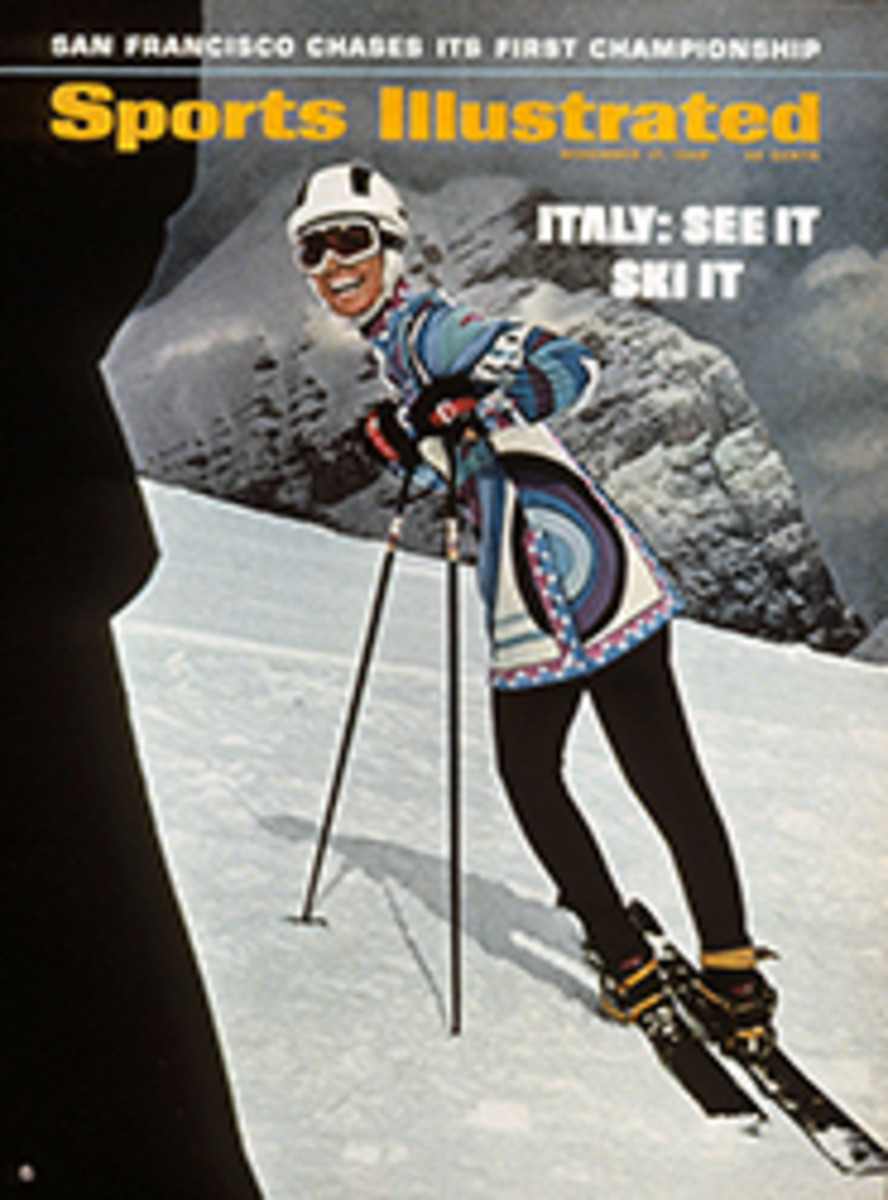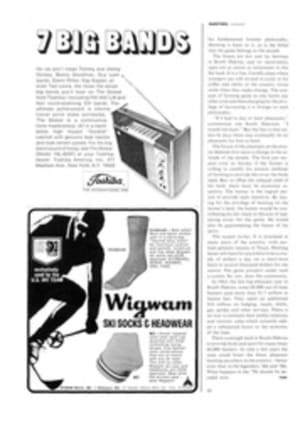
'Dice ball keeps the mind fit'
The Lexington Hotel on Chicago's South Side was once a headquarters for Al Capone. It contained his apartment, gymnasium and shooting gallery, where, rumor has it, the targets were often very realistic. The notorious days of the Lexington and the nearby red-light district are no more. The hotel is now called the New Michigan, and on its ground floor is Mama Batt's, a restaurant specializing in kreplach and matzo-ball soup—fare that would hardly have pleased Scarface. His ghost, however, might be pleased to know that on Monday evenings in the fall, dice are still being thrown in his old building. Batt's is the home stadium of a tabletop football league.
At 4 p.m. the players arrive at Batt's East, a room off the main restaurant. There are 24—the Old Gray Fox, Big Tom, Stump, et al.—and they remove their suits and open bags containing their uniforms. Big Tom Jillson is 6'3", 260, and once wrestled for Illinois. He struggles into black tights and red shorts with two big white buttons, dons Mickey Mouse ears, and with teammate Dave Petty goes to one of six game tables where await the B.C.s, dressed in Beatle wigs, T shirts and leopardskins.
Jillson sits in front of the game board and studies several defensive cards: "Good Against Strongside Off Tackle," "Weak Against Look-in Passes," "Best When You're in Doubt." He makes a disparaging remark about the B.C.s' ability to move the football, and the B.C.s batter Jillson's ears with plastic clubs.
At another table the Prince Valiant team of Bill Sloan and Gil McLendon is preparing to play Dick Tracy, a rookie outfit. Sloan believes it takes rookies at least one season to learn the complexities of the game—the percentage plays, the execution represented by the roll of the dice. Sloan and McLendon discuss last-minute game plans. "In exhibition games we played wide-open," McLendon says. "Now, we'll be more conservative." Sloan adds, "Lombardi would train at his strengths. In this game we'll go with our strengths." It is now 5 p.m., and the players get to their feet. A tape recorder plays the national anthem. The 1969 DFL (Donnelley Football League) season is under way.
The action at Batt's East is duplicated by an estimated 2,000 leagues throughout the U.S. All play Pro*Quarterback, manufactured by Championship Games, Inc., all are registered members of the AAU (Armchair Athletic Union), whose national commissioner is Tod Lansing, the game's inventor, and all read The AAU News, an eight-page tabloid featuring such articles as "NORAD Speeds Games to Lonely Arctic Sites." A number of companies produce tabletop football games—APBA, Milton Bradley, Strat-O-Matic, 3M—and each has a large following, with leagues on college campuses, in bars, suburban homes, commuter trains and at least one monastery. Tabletop games aren't restricted to football. APBA and Strat-O-Matic are best known for their baseball games. Lansing has invented one of several tabletop golf games, and it's possible to play hockey and basketball, too.
Tabletop devotees are notably fanatical. A Harrisburg, Pa. doctor thinks nothing of driving 105 miles to Philadelphia to play in a football league. An Ohio gasoline salesman refused transfer—and a promotion—until his company offered him an area where there was an APBA league. The Strat-O-Matic lunchtime baseball league at one office once completed a player draft over long-distance telephone hookups.
What accounts for this obsessive behavior? "It's the psychology of miniatures," says J. Richard Seitz, the inventor of APBA games. "You're creating an imaginary world relating to the real world of professional sports, but you're controlling it. You're the head coach, the manager." Hal Richman of Strat-O-Matic believes that advocates of table-top games are simply frustrated athletes. "We play these games because we're heroworshipers," he says, "and this is as close as we can get to the real game."
"My most glorious moment in sport came on the last day of our first table-top baseball season," one sportswriter admits. "I had to win to tie for the pennant. I was behind 1-0 in the bottom of the ninth. Luis Aparicio led off for me and flied to left. Willie Davis popped to first. Tony Conigliaro walked, and Frank Robinson was on via an error. Richie Allen tied the game with a double, and Denis Menke walked to load the bases. Up stepped Dick Stuart. He hit a home run, and to me that will always be as dramatic a homer as Bobby Thomson's."
Says Bill Sloan, DFL founder and commissioner, "I always play defense, and I try to put myself in Dick Butkus' place, wondering what he'd call. When my formation results in a fumble recovery, a big loss or an interception, I feel the same exhilaration Butkus must experience. There's nothing like it."
Sloan, like the other members of the DFL, works for Chicago's R.R. Donnelley & Sons, the nation's largest commercial printer. A tall, blond man in his mid-30s, he is pleasantly eccentric, a condition common to most tabletop enthusiasts. Sloan has always been fascinated by offbeat sports. Among these are Flockey—floor hockey played with paddles and a Ping-Pong ball—and winter golf, which is played with a tennis ball and hockey sticks.
Before Sloan was introduced to the Pro*Quarterback game his favorite pastime was Frisbee, which he facetiously claims to have invented. It was in 1952, five years before Wham-O first manufactured plastic Frisbees, that Sloan and Lincoln Dring stopped at a place in Hanover, N.H. which they have since dubbed Mrs. Frisbee's Pies. After consuming his pie, Sloan tossed the pie tin at Dring. Since that historic afternoon, he has thrown countless pie tins, garbage-can lids and, on one occasion, a hubcap from a 1962 Chevrolet.
"Aluminum units are best on a windy day," says Sloan. "When the thermals are just right, you've got it." He is now an accomplished Frisbee player, having mastered the Overhead Fandangle and the Sidearm Fantastic. He is still working on the Ming Thrust and the Wobbly, two of the game's most difficult throws. Sloan once made a thermal catch on a Ming Thrust, a Frisbee feat comparable to pitching a perfect game. "Frisbee keeps the body fit," he says. "The dice football game keeps the mind fit."
The DFL has thrived during its three-year history. (Despite its name, the league has no official connection with the company.) This season it expanded from eight to 12 teams and Sloan is considering going to 16 and four divisions. The success of the DFL has been due, in great part, to Sloan's diligence as commissioner. He was in Nassau on vacation last winter, enjoying a quiet dinner at the Emerald Beach Hotel with his wife Gale, when duty called—he left a plateful of conch fritters to phone Mama Batt's and get a rundown on the night's scores.
It once seemed that the DFL might crumble and the players return to bridge and bowling. The crisis arose last season when the Red Barons hadn't won a game. Joe Tubay and his Red Baron partner, John Witherspoon, began to seriously doubt each other's ability. In the final seconds of their sixth defeat, the Barons were driving toward the goal line. With the ball on the five, Witherspoon called the long bomb which, if completed, would have been caught 25 yards beyond the end zone. "We had a few words," Tubay recalled. "So what does he do? He lights my cape on fire!" This season Tubay has a new uniform and partner.
The cape-burning episode points out that tabletop players take their games as seriously as actual coaches. "If it's a crucial game, Bill is nervous all week long," Gale Sloan says. "At the start of the season he jokes about the league, and enjoys planning strategy. But in a few weeks it gets serious." Sloan and McLendon were undefeated during '67 regular season play, but lost the conference playoff. "That night Gil came home and I knew it would be best not to try to talk to him," Fran McLendon recalls. "As soon as he opened the door he began muttering, 'Bad dice, terrible execution,' over and over again. Eventually I went upstairs to bed."
Now it is 9 p.m. Sloan and McLendon's execution was flawless. Prince Valiant beat Dick Tracy 31-0, and the two men are in Mama Batt's bar celebrating. A friend, a stranger to the league, joins them and asks about the Chauncey Cup, a miniature of Rodin's Thinker, purchased for $30 at Sears Roebuck and named after the dog of one of Sloan's neighbors. "The Thinker is symbolic of the tabletop player," McLendon says of the trophy, which occupies a position of honor behind Batt's cash register. "It represents a guy in total concentration. I actually believe he isn't thinking about the next play in the game. He's trying to remember what he did with his clothes."
The first Chauncey Cup championship game, played on March 8, 1967, is the highpoint of DFL history. It took place at Sloan's home in South Holland, a respectable Dutch town 22 miles south of downtown Chicago. Goalposts were erected on the front lawn, along with a turnstile and a "searchlight." The league members had hoped for a real searchlight, something that would attract a large crowd. Sloan learned that one could be rented for $250 for a minimum of four hours. "How about $10 for 15 minutes?" he asked. The spotlight used that night was made from an ancient oscillating fan. Sloan tied two coffee cans onto it and placed two high-intensity bulbs inside. "We like to compare ourselves to Judge Hofheinz," he says. "He compromised by painting the roof of his Dome to prevent glare." What did attract a crowd, and created a traffic jam, were several DFL members picketing Sloan's house with such signs as "The End Is Here" and "DFL Unfair to Bo Chuck Pipers," a team that didn't qualify for the championship.
The game was played in Sloan's living room before 50 spectators. There was a miniature electric scoreboard, and a half-time show performed by the wives of league members.
The final game of the season was nearly as memorable. The DFL challenged the Carrol Stream Pro*Quarterback League, the other dice league in Chicago that plays Lansing's game, for the Armchair Athletic Union's Midwest Championship. Each league printed elaborate brochures containing player profiles and statistics. The DFL scouted their opponents from a "press box"—one member watched the Carrol Stream champions play their final game while standing on a chair.
"We were better organized," Sloan says. "We chose our best people to play according to statistics. We even had a cheering specialist. We won, but the evening wasn't a complete success: they brought a minister, and that took away half of our cheers."
Pulling off his Mickey Mouse ears, Tom Jillson joins Sloan and McLendon in the bar. "It took me 20 phone calls to find a place that sold these ears," he says. "And nobody knew what color shorts Mickey wears, what color shoes. I looked through the comic books at the Illinois Central Station and the closest was Donald Duck. I tried the Tribune. No help. I called Walt Disney Productions. The guy had to look it up. Mickey Mouse is dead."
After a toast to the departed, Sloan eyes the future. "We have always said we will drive one day in any direction to meet a challenge," he says. "We could drive 1,000 miles. If another league would do the same, we could play any dice football league in America."
PHOTO

